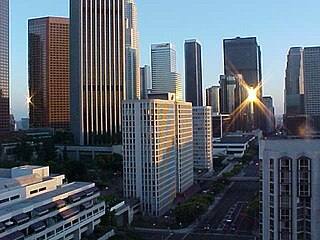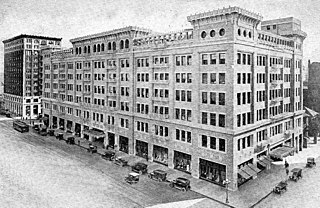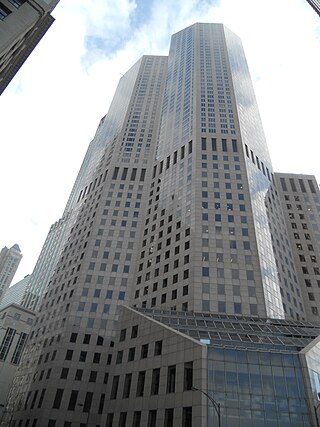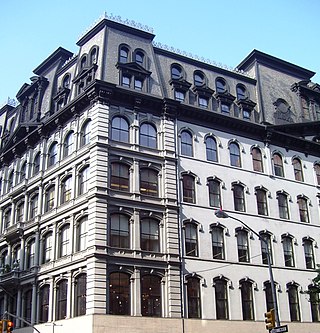
Downtown Crossing is a shopping district within downtown Boston, Massachusetts, located east of Boston Common, west of the Financial District, south of Government Center, and north of Chinatown and the old Combat Zone. It features large department stores as well as restaurants, souvenir sellers, general retail establishments, and street vendors. The Downtown Crossing MBTA station lies in the center of the district.
Strawbridge's, formerly Strawbridge & Clothier, was a department store in the northeastern United States, with stores in Pennsylvania, New Jersey, and Delaware. The Center City Philadelphia flagship store was, in its day, a gracious urban emporium. The retailer started adding branch stores starting in the 1930s and, by their zenith in the 1980s, enjoyed annual sales of over a billion dollars By the 1990s, Strawbridge's became part of the May Department Stores conglomerate until May's acquisition by Federated Department Stores on August 30, 2005.

The Financial District is the central business district of Los Angeles along Olive, Grand, Hope, Flower and Figueroa streets from 4th Street to 8th Street. It is south of the Bunker Hill district, west of the Historic Core, north of South Park and east of the Harbor Freeway and Central City West. Like Bunker Hill, the Financial District is home to corporate office skyscrapers, hotels and related services as well as banks, law firms, and real estate companies. However, unlike Bunker Hill which was razed and now consists of buildings constructed since the 1960s, it contains large buildings from the early 20th century, particularly along Seventh Street, once the city's upscale shopping street; the area also attracts visitors as the 7th and Flower area is at the center of the regional Metro rail system and is replete with restaurants, bars, and shopping at two urban malls.

J. W. Robinson Co., Robinson's, was a chain of department stores operating in the Southern California and Arizona area, previously with headquarters in Los Angeles, California.

One Magnificent Mile is a mixed-use high-rise tower completed in 1983 at the northern end of Michigan Avenue on the Magnificent Mile in Chicago containing upscale retailers on the ground floor, followed by office space above that and luxury condominium apartments on top. The 57-storey building was designed by Skidmore, Owings & Merrill and at the time of construction was the tenth-tallest building in Chicago.

Adam, Meldrum & Anderson Company (AM&A's) was a chain of department stores based in Buffalo, New York. It was an institution to generations of shoppers in the Buffalo area. The company remained family owned until its sale to The Bon-Ton in 1995.
Best & Co. was a department store founded in 1879 by Albert Best in New York City. The company initially sold clothing for infants and children, but later expanded to women's clothing and accessories. It was known for its "tastefully styled and proper women's clothes and its sturdy children's wear." Philip Le Boutillier served as president during the late 1930s. The store had expanded to 20 branches by 1966, when the company was acquired by McCrory's, who also operated Lerner Shops and S. Klein. In late-1970, McCrory's liquidated the company. At the time of its closing, the store had 1,200 employees.

The urban development patterns of Lexington, Kentucky, confined within an urban growth boundary that protects its famed horse farms, include greenbelts and expanses of land between it and the surrounding towns. This has been done to preserve the region's horse farms and the unique Bluegrass landscape, which bring millions of dollars to the city through the horse industry and tourism. Urban growth is also tightly restricted in the adjacent counties, with the exception of Jessamine County, with development only allowed inside existing city limits. In order to prevent rural subdivisions and large homes on expansive lots from consuming the Bluegrass landscape, Fayette and all surrounding counties have minimum lot size requirements, which range from 10 acres (40,000 m2) in Jessamine to fifty in Fayette.

Omni Superstore was a chain of supermarkets in the Chicago area and was owned by Dominick's. In 1997, Dominick's phased out Omni and converted the stores into Dominick's because the concept was not generating enough revenue compared to other Dominick's stores.

Hahne & Company, commonly known as Hahne's, was a department store chain based in Newark, New Jersey. The chain had stores located throughout the central and northern areas of New Jersey.
The H. & S. Pogue Company was a Cincinnati, Ohio based department store chain founded by two brothers, Henry and Samuel Pogue. They came from County Cavan, Northern Ireland, to Cincinnati and worked in their uncle's dry goods store. They later were able to buy him out and H. & S. Pogue Dry Goods Company was established in 1863 at 111 West Fifth Street. Brothers Thomas, Joseph, and William Pogue would eventually join the enterprise.


The Ladies' Mile Historic District was a prime shopping district in Manhattan, New York City at the end of the 19th century, serving the well-to-do "carriage trade" of the city. It was designated in May 1989, by the New York City Landmark Preservation Commission to preserve an irregular district of 440 buildings on 28 blocks and parts of blocks, from roughly 15th Street to 24th Street and from Park Avenue South to west of the Avenue of the Americas. Community groups such as the Drive to Protect the Ladies' Mile District and the Historic Districts Council campaigned heavily for the status.

The Lower Woodward Avenue Historic District, also known as Merchant's Row, is a mixed-use retail, commercial, and residential district in downtown Detroit, Michigan, located between Campus Martius Park and Grand Circus Park Historic District at 1201 through 1449 Woodward Avenue and 1400 through 1456 Woodward Avenue. The district was listed on the National Register of Historic Places in 1999.

The Arts & Entertainment District, or previously known as Omni, is a neighborhood of Downtown Miami, Florida. It is bound roughly by North 19th Street to the north, North 10th Street to the south, North West 2nd Avenue to the west, and Biscayne Boulevard to the east.

Arnold Constable & Company was a department store chain in the New York City metropolitan area. At one point it was the oldest department store in America, operating for over 150 years from its founding in 1825 to its closing in 1975. At the company's peak, its flagship "Palace of Trade" in Manhattan – located at 881-887 Broadway at East 19th Street, through to 115 Fifth Avenue – was acknowledged to be the store which took the largest portion of the "carriage trade", in New York, serving the rich and elite of the city, such as the wives of Grover Cleveland, Andrew Carnegie, Thomas Edison, J.P. Morgan, John D. Rockefeller and Cornelius Vanderbilt.
Haggarty's was a department store chain founded in Los Angeles in 1906, which closed in May 1970 due to not keeping up with fashion trends and a resulting $4.4 million in debts. It had more than a dozen branches at its peak.

7th Street is a street in Los Angeles, California running from S. Norton Ave in Mid-Wilshire through Downtown Los Angeles. It goes all the way to the eastern city limits at Indiana Ave., and the border between Boyle Heights, Los Angeles and East Los Angeles.

Parmelee-Dohrmann was a Los Angeles–based chain of stores that sold fine china, crystal, glassware, silver, and objects of art.

Retail in Southern California dates back to its first dry goods store that Jonathan Temple opened in 1827 on Calle Principal, when Los Angeles was still a Mexican village. After the American conquest, as the pueblo grew into a small town surpassing 4,000 population in 1860, dry goods stores continued to open, including the forerunners of what would be local chains. Larger retailers moved progressively further south to the 1880s-1890s Central Business District, which was later razed to become the Civic Center. Starting in the mid-1890s, major stores moved ever southward, first onto Broadway around 3rd, then starting in 1905 to Broadway between 4th and 9th, then starting in 1915 westward onto West Seventh Street up to Figueroa. For half a century Broadway and Seventh streets together formed one of America's largest and busiest downtown shopping districts.















